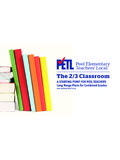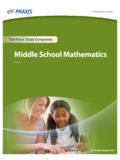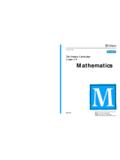Transcription of Grade 2 - Virginia Department of Education
1 Grade 2 Copyright 2009 by the Virginia Department of Education Box 2120 Richmond, Virginia 23218-2120 All rights reserved. Reproduction of these materials for instructional purposes in public school classrooms in Virginia is permitted. Superintendent of Public Instruction Patricia I. Wright, Assistant Superintendent for Instruction Linda M. Wallinger, Office of Elementary Instruction Mark R. Allan, , Director Deborah P. Wickham, , mathematics Specialist Office of Middle and High School Instruction Michael F. Bolling, mathematics Coordinator Acknowledgements The Virginia Department of Education wishes to express sincere thanks to Deborah Kiger Bliss, Lois A.
2 Williams, , and Felicia Dyke, who assisted in the development of the 2009 mathematics Standards of Learning Curriculum Framework. NOTICE The Virginia Department of Education does not unlawfully discriminate on the basis of race, color, sex, national origin, age, or disability in employment or in its educational programs or services. The 2009 mathematics Curriculum Framework can be found in PDF and Microsoft Word file formats on the Virginia Department of Education s Web site at mathematics Standards of Learning Curriculum Framework 2009: Grade 2 Virginia mathematics Standards of Learning Curriculum Framework 2009 Introduction The 2009 mathematics Standards of Learning Curriculum Framework is a companion document to the 2009 mathematics Standards of Learning and amplifies the mathematics Standards of Learning by defining the content knowledge, skills, and understandings that are measured by the Standards of Learning assessments.
3 The Curriculum Framework provides additional guidance to school divisions and their teachers as they develop an instructional program appropriate for their students. It assists teachers in their lesson planning by identifying essential understandings, defining essential content knowledge, and describing the intellectual skills students need to use. This supplemental framework delineates in greater specificity the content that all teachers should teach and all students should learn. Each topic in the mathematics Standards of Learning Curriculum Framework is developed around the Standards of Learning.
4 The format of the Curriculum Framework facilitates teacher planning by identifying the key concepts, knowledge and skills that should be the focus of instruction for each standard. The Curriculum Framework is divided into three columns: Understanding the Standard; Essential Understandings; and Essential Knowledge and Skills. The purpose of each column is explained below. Understanding the Standard This section includes background information for the teacher (K-8). It contains content that may extend the teachers knowledge of the standard beyond the current Grade level.
5 This section may also contain suggestions and resources that will help teachers plan lessons focusing on the standard. Essential Understandings This section delineates the key concepts, ideas and mathematical relationships that all students should grasp to demonstrate an understanding of the Standards of Learning. In Grades 6-8, these essential understandings are presented as questions to facilitate teacher planning. Essential Knowledge and Skills Each standard is expanded in the Essential Knowledge and Skills column. What each student should know and be able to do in each standard is outlined.
6 This is not meant to be an exhaustive list nor a list that limits what is taught in the classroom. It is meant to be the key knowledge and skills that define the standard. The Curriculum Framework serves as a guide for Standards of Learning assessment development. Assessment items may not and should not be a verbatim reflection of the information presented in the Curriculum Framework. Students are expected to continue to apply knowledge and skills from Standards of Learning presented in previous grades as they build mathematical K 3 STRAND: NUMBER AND NUMBER SENSE Grade LEVEL 2 mathematics Standards of Learning Curriculum Framework 2009: Grade 2 1 Students in grades K 3 have a natural curiosity about their world, which leads them to develop a sense of number.
7 Young children are motivated to count everything around them and begin to develop an understanding of the size of numbers (magnitude), multiple ways of thinking about and representing numbers, strategies and words to compare numbers, and an understanding of the effects of simple operations on numbers. Building on their own intuitive mathematical knowledge, they also display a natural need to organize things by sorting, comparing, ordering, and labeling objects in a variety of collections. Consequently, the focus of instruction in the number and number sense strand is to promote an understanding of counting, classification, whole numbers, place value, fractions, number relationships ( more than, less than, and equal to ), and the effects of single-step and multistep computations.
8 These learning experiences should allow students to engage actively in a variety of problem solving situations and to model numbers (compose and decompose), using a variety of manipulatives. Additionally, students at this level should have opportunities to observe, to develop an understanding of the relationship they see between numbers, and to develop the skills to communicate these relationships in precise, unambiguous terms. STANDARD STRAND: NUMBER AND NUMBER SENSE Grade LEVEL 2 mathematics Standards of Learning Curriculum Framework 2009: Grade 2 2 The student will a) read, write, and identify the place value of each digit in a three-digit numeral, using numeration models; b) round two-digit numbers to the nearest ten; and c) compare two whole numbers between 0 and 999, using symbols (>, <, or =) and words (greater than, less than, or equal to).
9 UNDERSTANDING THE STANDARD (Background Information for Instructor Use Only)ESSENTIAL UNDERSTANDINGS ESSENTIAL KNOWLEDGE AND SKILLS The number system is based on a simple pattern of tens where each place has ten times the value of the place to its right. Opportunities to experience the relationships among hundreds, tens, and ones through hands-on experiences with manipulatives are essential to developing the ten-to-one place value concept of our number system and to understanding the value of each digit in a three-digit number. Ten-to-one trading activities with manipulatives on place value mats provide excellent experiences for developing the understanding of the places in the Base-10 system.
10 Models that clearly illustrate the relationships among hundreds, tens, and ones are physically proportional ( , the tens piece is ten times larger than the ones piece). Students need to understand that 10 and 100 are special units of numbers ( , 10 is 10 ones, but it is also 1 ten). Flexibility in thinking about numbers is critical. For example, 123 is 123 ones; or 1 hundred, 2 tens, and 3 ones; or 12 tens and 3 ones. Rounding is finding the nearest easy-to-use number ( , the nearest 10) for the situation at hand. All students should Understand the ten-to-one relationship of ones, tens, and hundreds (10 ones equals 1 ten; 10 tens equals 1 hundred).
















